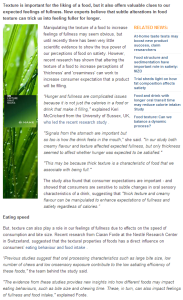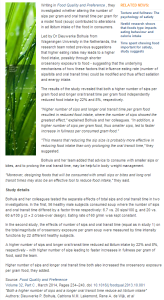Permit me to disclose right away that I am the principal inventor of the Overall Nutritional Quality Index (ONQI) algorithm, used in NuVal – a nutritional guidance system that stratifies foods from 1 to 100 on the basis of overall nutritional quality: the higher the number, the more nutritious the food. As the Chief Science Officer for NuVal, LLC, I am compensated for my continuous and considerable allocations of time and effort. But it was never supposed to be that way – and the reasons why it is are an important part of this story.
As to why this column now, there are two recent provocations. One is our ongoing work to complete the updated algorithm, ONQI 2.0, and the window that provides into a world of weirder foods than I ever even considered possible. The other is a paper published in the Journal of the Academy of Nutrition and Dietetics a few months back and a more recent exchange of letters related to that article. The article described the advantageous novelties of a nutritional profiling system, such as weighting nutrients for their health effects rather than counting them all the same. But this was less about novelty, and more about NuVal, since the innovations described have long been included in the ONQI.
[See: Debunking Common Nutrition Myths.]
Claims about alleged novelties that were already included in NuVal prompted a letter from my colleagues and me to the journal, which was published along with a response from the original authors. In that response, they acknowledged that the NuVal system included the so-called “novelties” and acknowledged that the ONQI is, to date, the only nutritional profiling system shown to correlate directly with health outcomes. So the real concern, the letter went on, is that the ONQI algorithm is proprietary and the details are not fully in the public domain.
Which brings us back to why NuVal is a private and proprietary system in the first place and whether or not it matters that certain details of the algorithm – which populate 25 pages or so of computer code written in a language called SAS – are not on a billboard. Why isn’t the ONQI public rather than private, and who really needs to know every detail of the algorithm for it to be useful? (All of the nutrients included in it, and the basic approaches used to generate scores, have been published.)
The ONQI, and NuVal, are a private sector innovation because the public sector said: no thanks. In 2003, I was privileged to be a member of a group of 15 academics invited to Washington, D.C. by then-Secretary of Health Tommy Thompson. A Food and Drug Administration task force had been formed to guide efforts related to the control of rampant obesity and diabetes, and we were a part of that effort. We gathered in a conference room with Secretary Thompson, the FDA Commissioner (Mark McClellan) and others, including the surgeon general and the heads of the National Institutes of Health and the Centers for Disease Control and Prevention.
[See: Why Aren’t Americans Healthier?]
We were each given one three-minute turn to offer up one good idea the FDA and other federal agencies might use to help combat the ominoustrends in diabetes and obesity. I used my turn to describe, in essence, the project that later became the ONQI. I suggested that the secretary might convene a totally independent group of top-notch experts in nutrition and public health, perhaps under the auspices of the Institute of Medicine.
The group should have no political or industry entanglements and should be allowed to work for as long as it took to convert the best available nutrition science and knowledge into a guidance system anyone could understand at a glance. I was thinking, in essence, of the equivalent of GPS for nutrition, so that no one trying to identify a better food in any given category would get lost, confused or misled by Madison Avenue.
[See: 10 Things the Food Industry Doesn’t Want You to Know.]
I waited two years for the feds to do something along these lines. When they didn’t, I decided to undertake the project myself, with the backing of Griffin Hospital in Derby, Conn. – a Yale-affiliated, not-for-profit community hospital, which owns the ONQI algorithm to this day. Other than this being a private rather than federal endeavor, all other aspects of the project were just as proposed to the U.S. Secretary of Health. When we completed the algorithm, I offered it again to the FDA. A scientist at the agency recommended a private-sector approach if I hoped to live long enough to see the system do its intended good.
Why didn’t the feds take on the project? We can all conjecture. I suspect it has something to do with the story Marion Nestle told us all in Food Politics, and the stories we routinely hear about the Farm Bill from the likes of Michael Pollan, Mark Bittman and others. The very government agencies that regulate the food supply are extensively entangled with the entities producing our food, from farm to factory. In comparison, we mere eaters of food have very little clout. The government may be just a little too conflicted on the topic of food to be in the business of putting the truth, the whole truth and nothing but the truth on at-a-glance display.
[See: Seeking a More Perfect Food Supply.]
Certainly the big food manufacturers, the makers of glow-in-the-dark snackattackables, should NOT be in the business of nutrition guidance whatever their inclination. That approach makes the fox look like a highly qualified security officer for the henhouse.
Which leaves independent nutrition, and public health experts and private sector innovation. And here we are.
Private-sector innovation often involves intellectual property, trade secrets and patent applications. It involves some entity making an investment and wanting a return. That is all true of NuVal, for better or worse. It wasn’t my plan – it was just the only way to get this empowering system into the hands of shoppers. Of note, the ONQI remains under the independent control of scientists, and not the business.
[See: Mastering the Art of Food Shopping.]
Which leads us back to the second question: Is it a problem for a system like this to be a private-sector innovation? Who, really, needs to know every detail of such an algorithm?
Consider that if you are shopping for a car, you do need to know if it comes with anti-lock brakes or all-wheel drive. But to decide if these are working for you, you don’t need engineering blueprints; you just need to drive in the snow. When shopping for a smartphone, you may want to know if it has GPS. But you don’t need the trigonometry equations on which the GPS is based to determine if it works; you just have to see if it helps you get where you want to go.
Nutrition guidance in general, and NuVal in particular, are just the same. What are the exact formula details? Who cares. We routinely rely on tools based on math and engineering most of us don’t understand – but we don’t need all that input to know if the tools are working for us. We just need the output. We need to be able to use them. People using NuVal have lost more than 100 pounds, and even over 200 pounds. Choosing higher scoring foods correlates with a lower risk of dying prematurely. More than 100,000 scores are on public display in 1,700 supermarkets nationwide. The ONQI is at least as transparent as any car or smartphone or computer.
[See: The No. 1 Skill for Weight Management.]
Let’s acknowledge: If you are reading this on a computer screen, neither of us truly understands the engineering involved in me writing it, using word processing software, attaching it to an email and sending it to my editor at U.S. News & World Report so she could post it in cyberspace, where you found it. But we do know it worked.
We rely on private-sector innovation for a lot of important jobs, and even many that put our safety on the line. The private sector makes our cars and planes. We seem to be comfortable using these without scrutinizing patent applications. The private sector makes our computers, and smartphones and GPS systems, and we can tell whether or not these work, even if we don’t know how.
Why, then, is nutrition guidance different? The answer, I believe, is politics, profits and the inertia of the status quo. We are accustomed to vague nutrition guidance from conflicted sources, and those same sources are apt to imply there is something wrong with private-sector innovation and the intellectual property issues that come along with it. But if those issues don’t undermine the cars, and planes and navigation systems that get us from city to city and coast to coast, it’s not at all clear why they should be a problem when navigating among choices in a supermarket aisle.
[See: The Government’s MyPlate Celebrates Second Birthday.]
As a scientist, and not a businessperson, my preference would be to put the ONQI on a billboard for all the good it would do. But on this, I must defer to the businesspeople who have made the relevant investments and are entitled to safeguard potential returns. As for the scrutiny that all advanced systems should get, the ONQI has been shared with scientists at leading universities and health agencies around the world – but for private assessment and use rather than public display. Others like them who want to review the program need only ask.
We should all care that the military-industrial establishment seems opposed to putting the blunt truth about nutritional quality, as best we know it, on at-a-glance display. We should care that federal authorities responsible for nutrition guidance are also responsible, if only indirectly, for food politics and supply-side profits. That story may lack novelty. It may be old news. But it is nonetheless something everyone who eats does need to know – engineering blueprints not required.





 This article is available online at:
This article is available online at: 